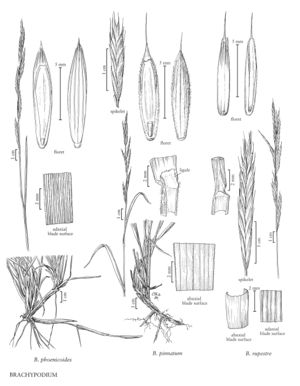Brachypodium rupestre
Plants perennial; cespitose, shortly rhizomatous. Culms 30-95(125) cm tall, 0.5-0.8 mm thick, narrowed below the racemes; nodes pubescent. Sheaths glabrous or hairy; ligules 0.4-2.4 mm, truncate; blades (9)15-40(52) cm long, 2.5-6.5(9) mm wide, stiff, involute or flat, light green, abaxial surfaces smooth or almost so, glabrous, conspicuously shiny, adaxial surfaces somewhat scabridulous, primary veins conspicuous, separated by finer secondary veins. Racemes (4)10-30(40) cm, with 5-9(12) spikelets. Spikelets (14)20-33(46) mm, terete or subterete, usually glabrous, with (7)10-17(24) florets; pedicels 0.6-2(3) mm. Glumes unequal, less than 1/3 the length of the spikelets, lanceolate, mucronate; lower glumes 4-8.5 mm, 3-6-veined; upper glumes 5.5-10.5 mm, 6-7-veined; lemmas 7-10.5(12) mm, lanceolate, 5-7-veined, awned, awns (2)3-10 mm; lodicules lanceolate, apices hairy, hairs stiff; anthers about 6 mm. Caryopses 5-7 mm. 2n = 14, 18, 28, 36.
Discussion
Brachypodium rupestre is native to Europe and northern Turkey; it is not known to be established in the Flora region. Specimens of this species were grown by the Natural Resources Conservation Service in Pima County, Arizona and Bernalillo County, New Mexico; they were distributed either as Brachypodium sp. or as B. cespitosum (Host) Roem. & Schult. The description is based on Schippmann (1991).
Selected References
None.
